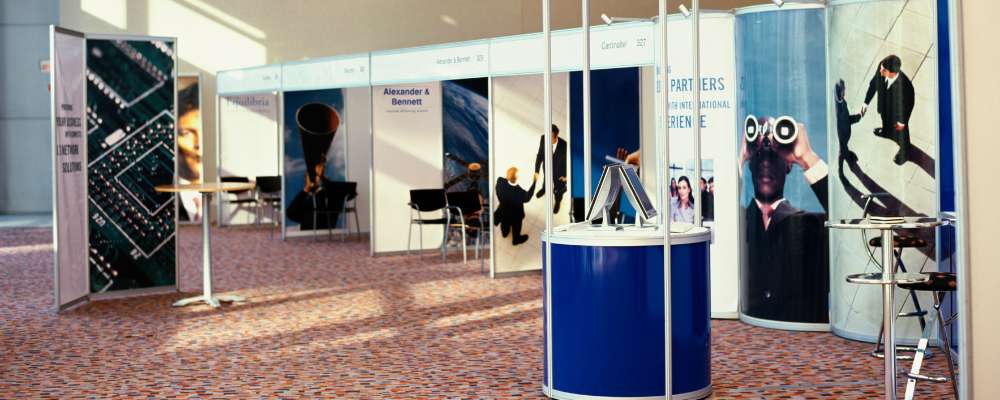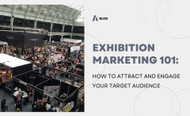Exhibition Marketing 101: How to Attract and Engage Your Target Audience
14th May 2023
Attention exhibitors! Are you struggling to attract and engage your target audience at trade shows and exhibitions? Don't worry; you're not alone. With so many booths competing for attention, it can be challenging to stand out from the crowd and make a lasting impression. However, with a well-planned strategy and the right tactics, you can successfully attract, engage and convert visitors into loyal customers. Want to know how to do it? Join us as we unveil the secrets to captivating your target audience and turning them into loyal customers.
What is the Purpose of this Blog Post?
In this blog post, we'll guide you through the essential steps of pre-event planning, attracting and engaging your target audience, and post-event follow-up. Whether you're a seasoned exhibitor or a first-timer, get ready to elevate your exhibition game and leave a lasting impression on your audience.
What is an Exhibition Booth?

When it comes to exhibiting at a trade show, exhibition, or conference, the exhibition booth is the centrepiece of your presence. An exhibition booth is:
- A temporary structure or space that exhibitors use to showcase their products and services at a trade show, exhibition, or conference.
- Ranging from a simple table with a banner to a complex structure with multiple levels, graphics, and interactive displays.
- A representation of your company's values, personality, and offerings, and an extension of your brand.
Overall, the exhibition booth is the heart of your exhibition marketing strategy. It's where you can make a lasting impression on potential customers, partners, or investors and stand out from your competitors and achieve your exhibition marketing goals..
Why is Exhibition Marketing Important?
Exhibitions are an excellent platform for businesses to showcase their products and services to a highly targeted audience. Exhibition marketing is important for businesses of all sizes and industries. In this blog post, we'll explore why exhibition marketing is crucial and how it can benefit your business.
Reach a Highly Targeted Audience
- Attendees at trade shows and exhibitions Exhibitions attract attendees who are interested in a specific industry or topic. This means that exhibitors have the opportunity to engage with a highly targeted audience, which can lead to better conversion rates.
- Focused audience with a shared interest Exhibitions provide a platform for businesses to showcase their products and services to a focused audience with a shared interest. This makes it easier for businesses to connect with potential customers who are more likely to be interested in their products or services.
Tangible and Interactive Way to Showcase a Brand
- Opportunity for visitors to touch and feel the product Exhibitions allow visitors to touch and feel products, which is not possible through other marketing channels. This creates a unique opportunity for businesses to showcase their products and services in a tangible way, which can help to build trust and confidence in their brand.
- Use interactive displays to create a lasting impression Interactive displays are an effective way to create a lasting impression on visitors. They provide an engaging and interactive experience for visitors, which can help to increase brand awareness and leave a lasting impression.
Generate leads, Sales, or Partnerships
- Short period of time to meet and engage with potential clients Exhibitions provide a unique opportunity for businesses to meet and engage with potential clients in a short period of time. This can help to generate leads, sales, or partnerships, which can have a positive impact on the business.
- Establishing new relationships with other businesses Exhibitions provide an excellent opportunity for businesses to establish new relationships with other businesses. These relationships can lead to partnerships, collaborations, and other opportunities that can help to grow the business.
Build Relationships, Trust, and Credibility
- Establishing brand authority through face-to-face interactions Exhibitions provide businesses with an opportunity to establish brand authority through face-to-face interactions with potential customers. This can help to build trust and credibility, which can have a positive impact on the business.
- Increasing customer retention through building trust Exhibitions provide an opportunity for businesses to build trust with potential customers. This can lead to increased customer retention, as customers are more likely to remain loyal to a brand they trust.
Gather Insights, Feedback, and Trends About Market and Competitors
- Observing and learning from competitors Exhibitions provide an opportunity for businesses to observe and learn from their competitors. This can help businesses to identify gaps in the market and make informed decisions about their products and services.
- Conducting surveys and feedback collection from attendees Exhibitions provide an opportunity for businesses to collect valuable feedback from attendees. This feedback can help businesses to improve their products and services and make informed decisions about their marketing strategy.
Are you convinced of the benefits of exhibition marketing, but feeling overwhelmed about where to begin? Don't worry, we've got you covered. In this next section, we'll guide you through the essential steps of pre-event planning to help you achieve your exhibition goals.
Pre-Event Planning for Exhibition Booths

If you are planning to showcase your products or services at an exhibition, it's essential to have a well-defined strategy that aligns with your objectives and audience. Here are five key steps for successful pre-event planning for exhibition booths:
Define Your Objectives and Audience
Before you start designing your exhibition booth, you need to determine your goals and objectives for the event. Do you want to generate leads, increase brand awareness, launch a new product, or strengthen your relationships with existing customers? Once you have defined your objectives, you need to identify your target audience, such as their demographics, interests, and pain points. This information will help you create messaging and branding that resonates with your audience. Use keyword research and competitor analysis to inform your approach and differentiate yourself from your competition.
Select the Right Exhibition and Booth Location
The success of your exhibition booth largely depends on the location and environment of the event. Research and compare different exhibitions and trade shows based on their audience, size, and industry focus. Choose a booth location that is easily accessible and visible, such as near the entrance, a main aisle, or a food court. Consider the layout and size of the booth, and how it fits your objectives and audience. Keep in mind that the location and size of the booth may impact the cost of the exhibition.
Design and Prepare Your Exhibition Booth
Your exhibition booth should reflect your brand identity and message in a creative and visually appealing way. Choose the right materials, furniture, and equipment that are functional, durable, and cost-effective. Create engaging and interactive displays, demos, or samples that showcase your products or services. Consider incorporating technology, such as tablets or touchscreens, to enhance the visitor experience. Make sure your booth design is consistent with your brand guidelines and messaging.
Staff and Train Your Exhibition Team
Your exhibition team is the face of your brand and the key to engaging with visitors. Recruit and train a team of personnel who are knowledgeable, friendly, and professional. Define their roles and responsibilities, such as lead generation, customer service, or product demonstration. Provide them with the necessary tools and resources, such as a lead tracking system, training manuals, or branded uniforms. Make sure they are aware of the exhibition goals and objectives, and are equipped to deliver the messaging and branding consistently.
Promote and Market Your Exhibition Booth
Promotion and marketing are crucial to drive traffic and generate leads for your exhibition booth. Develop a multi-channel promotion strategy that includes email marketing, social media, advertising, or PR. Create compelling and persuasive content that highlights the benefits and features of your products or services. Use targeted advertising to reach your audience and offer incentives, discounts, or exclusive content to encourage visitors to visit your booth. Make sure you measure the success of your promotion strategy and adjust it accordingly.
Preparing for an exhibition can be daunting, but with the right plan, you'll be set up for success. Once you've nailed your pre-event planning, it's time to focus on the next critical step: attracting your target audience. Let's dive into some tips and tactics to make sure your booth stands out from the crowd and draws in the visitors you're looking for.
Attracting Your Target Audience
Now that you have your exhibition booth set up, it's time to attract your target audience to your booth and make a great first impression. Here are some tips and tactics to consider:
Develop a Clear and Compelling Message
Craft a clear and concise message that effectively communicates the value proposition of your products or services. Ensure that your messaging is aligned with your branding and target audience. Use eye-catching graphics, slogans, and taglines to capture attention and create interest.
Use Technology to Enhance Your Booth Experience
Incorporate interactive displays, virtual reality, augmented reality, or gamification to engage visitors and create a memorable experience. Offer mobile apps or digital tools that enable visitors to explore your products or services in an innovative and interactive way. Use social media or digital signage to promote your booth and showcase your products or services in real-time.
Provide Valuable and Relevant Content
Offer free samples, demos, or consultations that demonstrate the value and quality of your products or services. Provide educational resources, such as whitepapers, case studies, or videos, that inform and educate visitors about your industry and solutions. Offer personalized recommendations or advice based on visitors' needs and preferences.
Build Relationships and Connections
Engage visitors in meaningful conversations that build rapport, trust, and credibility. Listen actively to visitors' needs and concerns, and offer personalized solutions and recommendations. Exchange contact information and follow up with visitors promptly to nurture relationships and close deals.
Offer Incentives and Promotions
Provide incentives, such as giveaways, contests, or raffles, that encourage visitors to participate and engage with your booth. Offer exclusive promotions, such as discounts, upgrades, or bundled packages, that entice visitors to buy or try your products or services. Create urgency or scarcity by offering limited-time offers or limited-quantity items.
By implementing these strategies and tactics, you can attract and engage your target audience, and make a great impression that leads to lasting relationships and business success.
Now that you've successfully attracted your ideal customers to your exhibition booth, what's next? Keep them engaged and create a lasting impression with these proven tactics.
Engaging Your Target Audience at Exhibition Booths
Attracting your target audience to your exhibition booth is only half the battle. To turn visitors into leads and potential customers, you need to engage them and create a memorable experience that resonates with them. Here are some tips and tactics for engaging your target audience at exhibition booths:
- Provide Interactive and Engaging Displays: Your booth should have interactive displays, demos, or samples that engage visitors and encourage them to interact with your products or services. This helps visitors understand your products or services better and enables them to visualize how they might use them in real life.
- Use Technology to Enhance Engagement: Leverage technology to make your exhibition booth stand out and attract visitors. Use digital displays, augmented reality, virtual reality, or 3D technology to create a unique and immersive experience that wows your audience.
- Encourage Participation: Create opportunities for visitors to participate in activities related to your products or services. Host contests, giveaways, or challenges that are fun and engaging. You can also create photo booths, social media walls, or other interactive experiences that visitors can share on social media.
- Provide Valuable Content: Offer valuable content that is relevant to your audience's needs and interests. This can be in the form of educational sessions, product demos, or workshops. You can also provide free resources such as whitepapers, eBooks, or industry reports that visitors can download.
- Use Social Proof: Incorporate social proof into your exhibition booth to build trust and credibility with your audience. This can be in the form of customer testimonials, case studies, or awards. Seeing that other people have used and enjoyed your products or services can be a powerful motivator for visitors to engage with your brand.
After putting in all the effort to attract and engage your target audience at your exhibition booth, it's easy to assume that the hard work is done. However, the real work begins after the event. In the next section, we'll show you how to effectively follow up with your leads and analyze your performance to ensure that you get the most out of your exhibition marketing efforts. So, let's dive into post-event follow-up for exhibition booths.
Post-Event Follow-Up for Exhibition Booths
Exhibiting at an event doesn't end when the show does. To make the most out of your investment, you need to follow up with leads, evaluate your performance, and adjust your strategies for future events. Here are some tips on how to effectively follow up after an event:
Organize and Analyze Data Collected
- Categorize and Prioritize Leads: Sort the leads, inquiries, and feedback received from visitors by their level of interest, job title, company size, or any other relevant criteria.
- Use Data Analytics Tools: Utilize data analytics tools to gain insights and trends from your leads and measure the success of your exhibition performance.
- Create a Centralized Database: Maintain a centralized database of leads and their contact information that is accessible to your sales and marketing teams.
Follow Up with Leads Promptly
- Send Personalized Follow-Up Messages: Send personalized and relevant follow-up messages to your leads, based on their interests, needs, and preferences.
- Provide Value: Offer valuable content, such as case studies, white papers, or industry insights, that demonstrates your expertise and adds value to your leads.
- Convert Leads into Customers or Advocates: Use a CRM system to track the progress of your leads and convert them into customers or brand advocates.
Evaluate Your Performance and Adjust Strategies
- Measure Exhibition ROI: Calculate the return on investment (ROI) of your exhibition and compare it with your goals and objectives.
- Analyze Your Strengths and Weaknesses: Identify your strengths and weaknesses in terms of booth design, messaging, lead generation, and follow-up.
- Identify Areas for Improvement: Use the insights gained from your data analysis and feedback to adjust your strategies and improve your future exhibition marketing efforts.
As a final note, we at FSE Group understand the importance of exhibition marketing and the impact it can have on your business. That's why we're committed to providing you with the tools and resources you need to succeed at your next event. From pre-event planning to post-event follow-up, we're here to support you every step of the way. So, don't hesitate to reach out to us for any assistance you may need.
Conclusion
In order to maximize the success of your exhibition booth, it is important to plan ahead and execute a well-thought-out strategy. By attracting and engaging your target audience, you can create a lasting impression and build meaningful relationships with potential customers. And by following up promptly and effectively, you can convert leads into loyal customers.
Don't wait until the next trade show to implement these strategies! Start planning now and take action to improve your exhibition marketing efforts. Whether it's identifying your target audience or analyzing your performance, take the first step towards success today and see the results for yourself.
We hope these tips and tactics have been helpful in your exhibition marketing journey. If you have any questions or would like further assistance, please don't hesitate to contact us. Additionally, we invite you to explore our other blog posts for more valuable insights and information. Thank you for reading!

